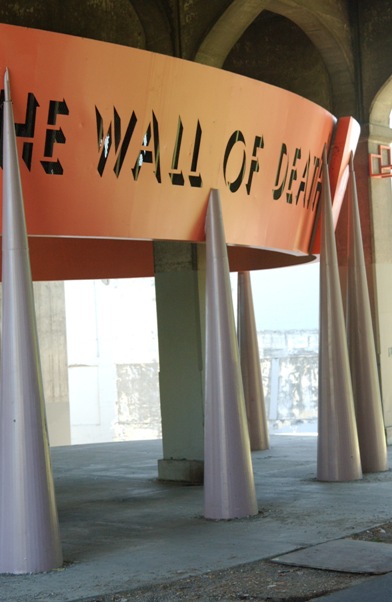Installed in 1993, The Wall of Death may occupy, after the Fremont Troll, the worst site for public art in Seattle. Its only visible to those on the Burke-Gilman Trail and UW students and staffers traversing down to the Portage Bay side of campus. It gets almost no sun, and even less attention from the crowd of young skateboarders using the ramp opposite the BGT. Was it put there because people hated it? Because it was controversial or cost too much, a case of benefactors regret? Yes and no. Canadian sculptor Mowry Baden and his architect son, Colin Baden, signed off on the location after a long battle with the Seattle Arts Commission (which put up $100,000 for their proposal). After several rejected ideas, they built what they wanted. The city put it where it wanted. Then everyone washed their hands of the project. Today, the forlorn orange ring is delicately balanced on 10 metal spires to somewhat mysterious purpose. Though boldly identified to passersby, only older trail users are likely to know what that screaming signage, The Wall of Death, and shape signify. Once, long before cage fighting and Evel Knievels canyon jumping, barnstorming motorcyclists were the extreme-sports daredevils of their daychiefly the 20s and 30s. Theyd race into a circular wooden ring, achieve enough speed to stick to the vertical inner wall with centrifugal force; then the bottom would drop out, or the ring raise up, to the awe of circus onlookers. It was high-octane, no-health-care, reckless bad-assery of the highest and finest order. And now, in a perhaps fitting sense, the sculpture is a hidden relic, a signifier of forgotten times and sports. Back in 93, parked and abandoned cars littered the site; the under-bridge area was more of a vehicular wasteland. Now its surrounded by new office space and UW labs. In a way, Wall of Death is like the Cadillac Ranch in Texasa monument to internal-combustion dinosaurs, whose bones are all that remains from their rule on Earth. BRIAN MILLER
Starts: Sept. 17. Daily, 2008




